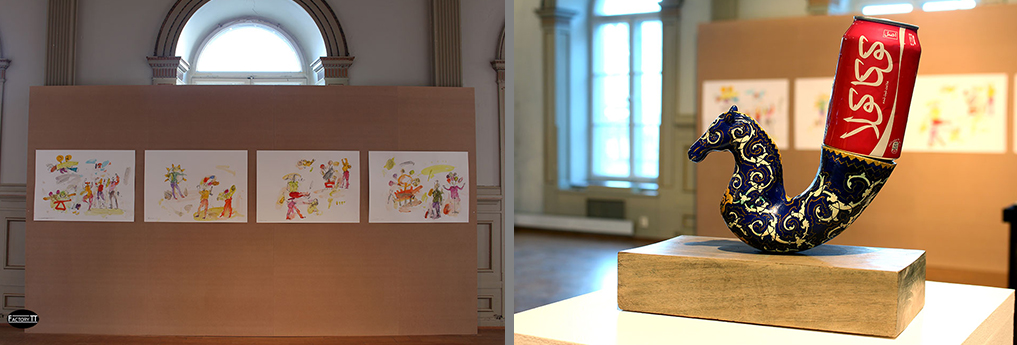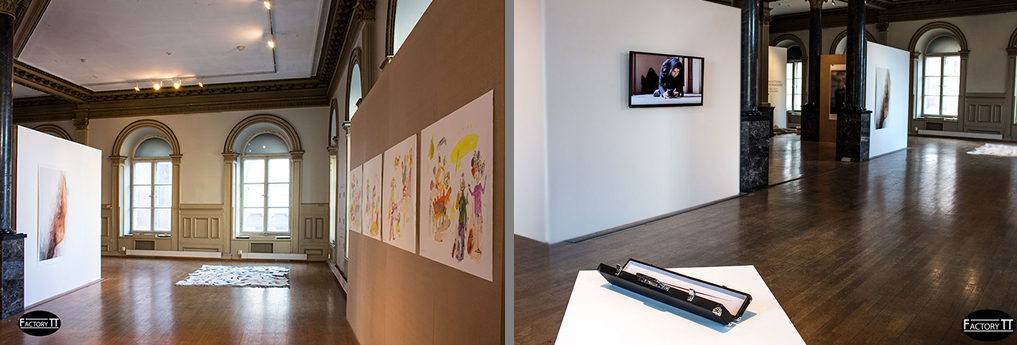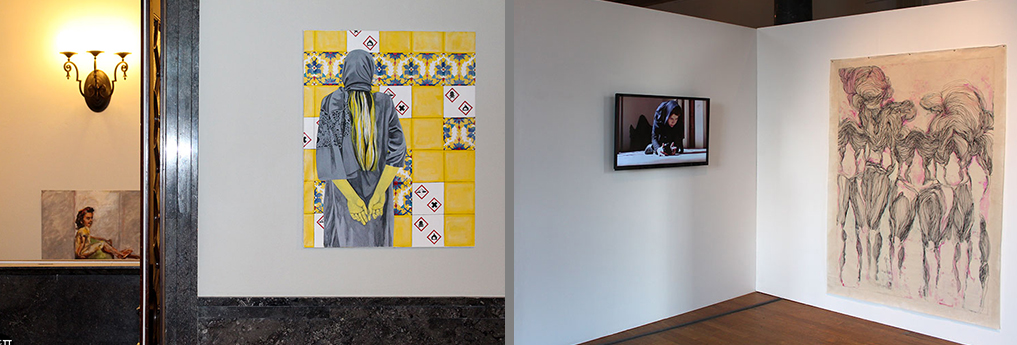


Beyond the Exhibit 314
Contextualising of the Emerging Iranian Artists
Exhibition 2nd March to 15st April 2018
KUNSTHALL 3.14, Bergen, Norway
Curated by: Shahram Entekhabi and Asieh Salimian
Participating artists (among others): Negar Alemzade Gorji ; Mostafa Choobtarash ; Negar Ghiamat ; Fahime Haghighi ; Sara Hosseini Sefiddashti ; Roohangiz Safarinezhad ; Shahryar Rezaei ...
2nd March 2018, Panel discussion organized in conjunction with exhibition:
Impacts on the Iran art scene today
with: Lise Rakner, Professor Department of Comparative Politics, University of Bergen ; Toril Hansen from PEN Vestlandet ; Malin Barth, Director of Kunsthall 3.14 ; Shahram Entekhabi and Asieh Salimian
Beyond the Exhibit 314
(scroll down for Farsi)
The starting point for Beyond the Exhibit 314 is the observation the lack of an institutional system for contemporary art in Iran, the lack of international exchange and the shortcomings in the field of education. If originally the few, more underground-based, off-market galleries were oriented towards an alternative-experimental understanding of art, today a gallery system based on economic speculation and plagiarism has emerged - also under the influence of the buyers from the Arab Emirates and Western art agents and the decorative in the foreground. This created a single market that has little in common with the value of an international art community.
The artistic work, which deals with real social problems and gives art a social relationship, has almost been abandoned in the big Iranian cities under the influence of the decades-long embargo and the subsequent domestic destabilization. All forms of art relatedness have been lost abandoned the influence of a decades-long embargo and a domestic political destabilization. The Contemporary art in Iran often seeks its cultural identity in past dynasties and historical processes from before the Islamic Revolution. The present and the future, topics such as the work-up of the Iran-Iraq war or the real living conditions in an Islamic republic, are hard to find in this search for identity. In contrast, the image of Iranian art in the West is left to a few Western curators who, for the most part, detach a few contemporary works from a limited gallery system. By these observations, Factory TT set itself the task of becoming agents of another Iranian contemporary art.
The exhibition project Beyond the Exhibit 314, Contextualizing Emerging Iranian Artists introduces young Iranian artists born after the Islamic Revolution of 1978/1979. All participants have completed a university and try to work as full-time artists. Most came to Tehran from other cities; six participants live elsewhere: in Karaj, Kerman and Isfahan. In the selection of the artists less their exhibition biography played a role, but rather the presence of a socialization in their works. The title of the exhibition indicates that the project goes beyond the mere presentation of artistic works. All exhibition contributions are accompanied by interviews with the participants, initiated, directed and filmed by the artist Shahram Entekhabi. These video clips shed light on the respective artistic career, the social position of the artist, the conditions of production and their theme world. Beyond the Exhibit is planned as a continuous series of exhibition projects in various locations in Germany and abroad.
After her law studies Negar Alemzade Gorji turned exclusively to art and questioned stereotypical gender roles. Mustafa Choobtarash from Dezful on the Persian Gulf is working on the effects of the eight-year Iran-Iraq war. Negar Ghiamat addresses the vulnerability of man and nature. Fahimeh Haghighi lives in Isfahan and works as a teacher with marginalized children on the margins of society, to whom she gives a face in her painting. Sarah Hosseini Sefiddashti from Isfahan's photorealistic paintings deals with the situation of women in public places, especially with a large number of acid attacks in Isfahan and their psycho-social impact on society. Roohangiz Safarinezhade leads a consumer-critical discourse and addresses the impact of industrial society on the environment. Shahryar Rezaei from the desert town of Kerman works on the subject of rural migration and migration...
Asieh Salimian
2018
––––––––––––––––––––––––––––––––––––––––––––––––––
بررسی زمینه های پیدایش اثرِ هنرمندان نوظهور ایرانی
کیوریتورها: شهرام انتخابی ; آسیه سلیمیان
از جمله هنرمندان شرکت کننده: مصطفی چوب تراش ; سارا حسینی ; فهیمه حقیقی ; شهریار رضایی ; روح انگیز صفری ; نگار زهرا عالم زاده گرجی ; نگار قیامت
دوازدهم اسفند ۱۳۹۶ تا ۲۶ فروردین۱۳۹۷
کونست هال ۳۱۴, برگن, نروژ
یازدهم اسفند ۱۳۹۶ جلسه بحث و گفت و گو پیرامون موضوع: صحنه هنر امروز ایران
با حضور: لیز راکنر، پروفسور دپارتمان سیاست تطبیقی دانشگاه برگن ; توریل هانسن، انجمن جهانی قلم ; مالین بارث، مدیر هنری موزه ی کونست هال ۳.۱۴، برگن, نروژ ; شهرام انتخابی و آسیه سلیمیان
نقطه شروع فراتر از نمایش ۳۱۴، مشاهده عدم وجود سیستم نهادی برای هنر معاصر در ایران، فقدان تبادل بین المللی و نقص در زمینه آموزش بود. در اوائل شکل گیری صحنه هنر معاصر در ایران به خصوص تهران، تعداد محدودی گالری به صورت زیرزمینی فعال بودند، که دور از بازار رویکردی بر اساس هنر تجربی داشته اند و استفاده از روش و مدیوم های جدید را پشتیبانی می کردند. امروز تحت تاثیر خریدارانی از امارات متحده عربی و واسطه گران هنرغرب اکثر گالری ها ساز وکاری توسعه یافته در پیش گرفتند که در آن جنبه ی تزئینی و گمانه زنی اقتصادی نقش اصلی را بازی می کند. بر این مبنا، بازاری داخلی به وجود آمده که با ارزش های هنر انتقادی بین الملی کمتر در ارتباط است. امر هنری که نشان دهنده ی مسائل اجتماعی واقعیست و پیوندی را با جامعه در هنر بازتاب می دهد، در شهرهای بزرگ ایران تحت تأثیر تحریم های دهه های گذشته و بی ثباتی داخلی قرار دارد. تولیدات هنر معاصر ایران اغلب هویت فرهنگی خود را در سلسله های گذشته و فرایندهای تاریخی قبل از انقلاب اسلامی دنبال می کنند. موضوعاتی مانند مسائل مربوط به کار، جنگ ایران و عراق، یا شرایط زندگی واقعی در جمهوری اسلامی و به طور کلی زمان حال و آینده، کمتر نقشی در هویت یابی هنری بازی می کند. از سوی دیگر، تصویری از هنر معاصر ایران در غرب توسط برخی از مظنونین همیشگی ارائه می شود، که بدون در نظر گرفتن محتوا و روبرویی با وضعیت موجود، در خلوت آثاری را در یک سیستم گالری منحصر به فرد می یابند. با این تفاسیر فاکتوری تی تی هدف خود را معرفی تصویری بروزتر و متنوع تر از هنر معاصر ایران قرار داده است. فراتر از نمایش ۱ زمینه های پیدایش اثرِ هنرمندان نوظهور ایرانی را بررسی کرده و عمدتا هنرمندان ایرانی را که بعد از انقلاب اسلامی ۱۳۵۷ به دنیا آمده ا ند معرفی می کند. هنرمندان دعوت شده به این پروژه دانش آموخته هنر از دانشگاه های ایران هستند و در تلاشند که به عنوان هنرمند تمام وقت فعالیت داشته باشند. اکثرا از شهرهای دیگر به تهران آمده و پنج هنرمند در اصفهان و کرمان و کرج زندگی می کنند. عنوان نمایشگاه حاکی از این است که این پروژه ها فراتر از ارائه آثار هنری هستند. در انتخاب هنرمندان؛ شخصیت، حضور در صحنه ی هنر و دغدغه اجتماعی و بیان هنری شان اهمیت بیشتری نسبت به لیست نمایشگاه های آنها دارد. مصاحبه با تک تک هنرمندان شرکت کننده سهم مهمی در شکل گیری این نمایشگاه ها دارند، که به وسلیه هنرمند شهرام انتخابی و آسیه سلیمیان کارگردانی و فیلمبرداری می شوند. این کلیپ های ویدئویی اطلاعاتی در مورد حرفه، موقعیت اجتماعی، شرایط تولید و تم آثار آن ها ارائه می دهد. به طور کلی این فیلم ها تصویری بسیار شخصی از وضعیت کنونی هنرمندان در ایران را نشان می دهد. فراتر از نمایش به عنوان مجموعه ای پیوسته برنامه ریزی شده است، که پروژه های نمایشگاهی به همراه جلسات بحث و گفتگو در نقاط مختلف ایران و خارج از کشور را برگزار می کند. نگار زهرا عالم زاده گرجی ؛ پس از گذراندن دوران کاری به عنوان وکیل، به صورت انحصاری به هنر رو آورده و کلیشه و نقش و طبقه بندی جنسیت را در ویدئو و نقاشی هایش زیر سوال می برد. مصطفی چوب تراش ؛ با طنز و رویکردی شخصی با تاریخ روبروست، و در چیدمان و نقاشی هایش یک نوع بازخوانی تاریخی با رویکرد نقد طنز آمیز اجتماعی و فرهنگی حضور دارد. نگار قیامت در فتوگراف ها و نقاشی هایش به آسیب پذیری انسان و حساسیت طبیعت اشاره و آنها را محوراصلی آثارش قرار داده. فهیمه حقیقی در اصفهان زندگی می کند. نبود امنیت، جستجوی حریم شخصی و مصائب کودکان در جامعه را بررسی کرده و آن سوژه اصلی نقاشی هایش است. سارا حسینی سفید دشتی نقاشی ساکن اصفهان است که وضعیت زنان در جامعه، به ویژه اثرات حملات اسید پاشی و به طور کلی خشونت اجتماعی علیه زنان را مطرح می کند. روح انگیز صفری نژاد ؛ نگاهی انتقادی به مصرف گرایی انداخته و به تاثیر جامعه صنعتی بر محیط زیست می پردازد. شهریار رضایی ؛ مجسمه ساز و فعال در چیدمان های فضای عمومی است، در آثار وی دغدغه های اجتماعی مردم آزادی وطن و مهاجرت، مشهود است
آسیه سلیمیان
۱۳۹۷ فروردین